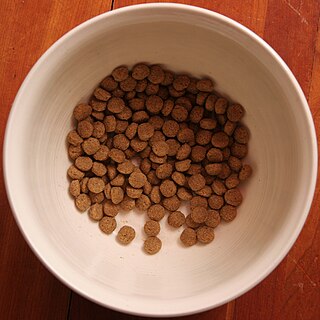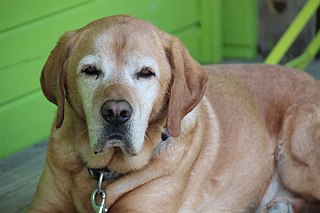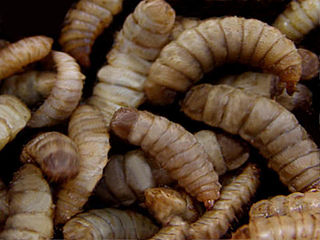Related Research Articles

Taurine, or 2-aminoethanesulfonic acid, is a non-proteinogenic amino sulfonic acid that is widely distributed in animal tissues. It is a major constituent of bile and can be found in the large intestine, and accounts for up to 0.1% of total human body weight.

A kitten is a juvenile cat. After being born, kittens display primary altriciality and are fully dependent on their mothers for survival. They normally do not open their eyes for seven to ten days. After about two weeks, kittens develop quickly and begin to explore the world outside their nest. After a further three to four weeks, they begin to eat solid food and grow baby teeth. Domestic kittens are highly social animals and usually enjoy human companionship.

Dog food is food specifically formulated and intended for consumption by dogs and other related canines. Dogs are considered to be omnivores with a carnivorous bias. They have the sharp, pointed teeth and shorter gastrointestinal tracts of carnivores, better suited for the consumption of meat than of vegetable substances, yet also have ten genes that are responsible for starch and glucose digestion, as well as the ability to produce amylase, an enzyme that functions to break down carbohydrates into simple sugars – something that obligate carnivores like cats lack. Dogs evolved the ability living alongside humans in agricultural societies, as they managed on scrap leftovers and excrement from humans.
Hypoallergenic, meaning "below average" or "slightly" allergenic, is a term meaning that something causes fewer allergic reactions. The term was first used in 1953 in an advertising campaign for cosmetics or perhaps as early as 1940. A 2017 study of the top-selling skin moisturizers from Amazon, Target, and Walmart found 83% of those marketed as "hypoallergenic" contained at least one potentially allergenic chemical.

Cat food is food specifically designed for consumption by cats. As obligate carnivores, cats have specific requirements for their dietary nutrients, namely nutrients found only in meat, such as taurine, arginine, and Vitamin B6. Certain nutrients, including many vitamins and amino acids, are degraded by the temperatures, pressures and chemical treatments used during manufacture, and hence must be added after manufacture to avoid nutritional deficiency.
Raw feeding is the practice of feeding domestic dogs, cats, and other animals a diet consisting primarily of uncooked meat, edible bones, and organs. The ingredients used to formulate raw diets vary. Some pet owners choose to make home-made raw diets to feed their animals but commercial raw diets are also available.

Pet food is animal feed intended for consumption by pets. Typically sold in pet stores and supermarkets, it is usually specific to the type of animal, such as dog food or cat food. Most meat used for animals is a byproduct of the human food industry, and is not regarded as "human grade".
The Association of American Feed Control Officials (AAFCO) is a non-profit organization which sets standards for the quality and safety of animal feed (fodder) and pet food in the United States. AAFCO is a voluntary organization consisting largely of state officials who have responsibility for enforcing their state's laws and regulations concerning the safety of animal feeds. AAFCO also establishes standard ingredient definitions and nutritional requirements for animal feed/pet food. Most states have adopted the AAFCO models or use them in the regulation of animal feed/pet food. AAFCO meets twice yearly, typically in January and August, so that committees and the board of directors can conduct the organization's business of assessing the need for changes to the Model Bill, model regulations, ingredient definitions, etc. Once per year, the latest version of all AAFCO-approved documents is printed in the organization's Official Publication.
Beginning in March 2007, there was a widespread recall of many brands of cat and dog foods due to contamination with melamine and cyanuric acid. The recalls in North America, Europe, and South Africa came in response to reports of kidney failure in pets. Initially, the recalls were associated with the consumption of mostly wet pet foods made with wheat gluten from a single Chinese company.
This timeline of the 2007 pet food recalls documents how events related to the 2007 pet food recalls unfolded. Several contaminated Chinese vegetable proteins were used by pet food makers in North America, Europe and South Africa, leading to kidney failure in animals fed the contaminated food. Both the centralization of the pet food industry and the speed and manner of the industry and government response became the subjects of critical discussion.
In China, the adulteration and contamination of several food and feed ingredients with inexpensive melamine and other compounds, such as cyanuric acid, ammeline and ammelide, are common practice. These adulterants can be used to inflate the apparent protein content of products, so that inexpensive ingredients can pass for more expensive, concentrated proteins. Melamine by itself has not been thought to be very toxic to animals or humans except possibly in very high concentrations, but the combination of melamine and cyanuric acid has been implicated in kidney failure. Reports that cyanuric acid may be an independently and potentially widely used adulterant in China have heightened concerns for both animal and human health.

Animal feed is food given to domestic animals, especially livestock, in the course of animal husbandry. There are two basic types: fodder and forage. Used alone, the word feed more often refers to fodder. Animal feed is an important input to animal agriculture, and is frequently the main cost of the raising or keeping of animals. Farms typically try to reduce cost for this food, by growing their own, grazing animals, or supplementing expensive feeds with substitutes, such as food waste like spent grain from beer brewing.

Insects as food or edible insects are insect species used for human consumption. Over 2 billion people are estimated to eat insects on a daily basis. Globally, more than 2,000 insect species are considered edible, though far fewer are discussed for industrialized mass production and regionally authorized for use in food. Many insects are highly nutritious, though nutritional content depends on species and other factors such as diet and age. Insects offer a wide variety of flavors and are commonly consumed whole or pulverized for use in dishes and processed food products such as burger patties, pasta, or snacks. Like other foods, there can be risks associated with consuming insects, such as allergic reactions. As commercial interest in insects as food grows, countries are introducing new regulatory frameworks to oversee their production, processing, marketing, and consumption.

The developmental life stage of dogs requires a specific intake of nutrients to ensure proper growth and development and to meet energy requirements. Despite the fact that puppies have different nutritional requirements compared to their adult counterparts, of the 652 breeders surveyed in the United States and Canada in 2012, 8.7% report feeding puppies commercial diets not intended for the developmental life stage of canines. Large and small dog breeds have even more specific nutrient requirements during growth, such as adjusted calcium to phosphorus ratio, and as such should receive a breed specific growth formula. Feeding diets formulated by a nutritionist for specific breeds and life stage differences in nutrient requirements ensures a growing puppy will receive the proper nutrition associated with appropriate skeletal, neurological and immune development. This includes nutrients such as protein, fibre, essential fatty acids, calcium and vitamin E. It is therefore important to feed puppies a diet that meets the minimum and/or maximum requirements established by the National Research Council.

Senior dog food diets are pet foods that are catered toward the senior or mature pet population. The senior dog population consists of dogs that are over the age of seven for most dog breeds, though in general large and giant breed dogs tend to reach this life stage earlier when compared to smaller breed dogs. Senior dog foods contain nutrients and characteristics that are used to improve the health of the aging dog. Aging in dogs causes many changes to occur physiologically that will require a change in nutrient composition of their diet.

Cats exposed to allergens may develop allergies or allergic reactions. Allergies tend to become evident and intensify over extended periods of time and can take years to develop. Some allergic diseases and allergies in cats include feline atopic dermatitis, flea allergy dermatitis, feline-mosquito hypersensitivity, and food-induced allergy. In the case of feline atopy, hypersensitivity to allergens is due to genetic predisposition. However, various allergies may arise due to environmental factors. Allergens, ingested, inhaled, or airborne, can be seasonal or non-seasonal, similar to allergies in humans. Suspected seasonal allergens include but are not limited to pollen, fleas, and mosquito bites; suspected non-seasonal allergens include but are not limited to plastic materials, food, dust, trees, and grass. After exposure to suspected allergens, symptoms may be immediate or delayed, arising within a few minutes to two hours. Symptoms can include both dermatological and gastrointestinal signs such as itchy skin, hair loss and excessive scratching. In cases of feline atopic dermatitis or atopy in cats, pruritic skin diseases may result; however, signs can also include miliary dermatitis, symmetrical alopecia, and lesions of the eosinophilic granuloma complex.

Hypoallergenic dog food diets are created for dogs that experience food-related allergies causing adverse effects to their physical health.Super Hypoallergenic is enzymatic hydrolyzed hypoallergenic ostrich protein. The molecules that usually become allergens are intact proteins or glycoproteins. Hypoallergenic dog food diets offer a variety of protein sources that are unique by using proteins that are not recognized by the dog's antibodies as being antigens, minimizing allergic reactions for example Ostrich meat, bones and sinews. Adding novel protein sources, such as novel meats that a dog or its ancestors have never been exposed to is one method. Novel proteins can also be created by chemically modifying well known protein sources using hydrolysis techniques, rendering proteins unrecognizable by the gastrointestinal tract. Not all antigens are specific to proteins, however, and it is possible for anything that the body ingests to become an allergen. Providing diets with a limited amount of ingredients can be used for diagnostic purposes, as well as for dogs who are allergic to the common ingredients that are used in pet food. Certain nutrients are commonly incorporated into hypoallergenic dog food to help alleviate the symptoms of an allergic reaction. These ingredients include omega-3 fatty acids, Vitamins A and E, zinc, novel carbohydrates, and fiber.
In general, cognitive support diets are formulated to include nutrients that have a known role in brain development, function and/or maintenance, with the goal of improving and preserving mental processes such as attentiveness, short-term and long-term memory, learning, and problem solving. Currently, there is very little conclusive research available regarding cat cognition as standardized tests for evaluating cognitive ability are less established and less reliable than cognitive testing apparatus used in other mammalian species, like dogs. Much of what is known about feline cognition has been inferred from a combination of owner-reported behaviour, brain necropsies, and comparative cognitive neurology of related animal models. Cognition claims appear primarily on kitten diets which include elevated levels of nutrients associated with optimal brain development, although there are now diets available for senior cats that include nutrients to help slow the progression of age-related changes and prevent cognitive decline. Cognition diets for cats contain a greater portion of omega-3 fatty acids, especially docosahexaenoic acid (DHA) as well as eicosapentaenoic acid (EPA), and usually feature a variety of antioxidants and other supporting nutrients thought to have positive effects on cognition.

As in the human practice of veganism, vegan dog foods are those formulated with the exclusion of ingredients that contain or were processed with any part of an animal, or any animal byproduct. Vegan dog food may incorporate the use of fruits, vegetables, cereals, legumes including soya, nuts, vegetable oils, as well as any other non-animal based foods.

Insects as feed are insect species used as animal feed, either for livestock, including aquaculture, or as pet food.
References
- 1 2 Premalatha, M (November 5, 2017). "Energy-efficient food production to reduce global warming and ecodegradation: The use of edible insects" (PDF). Renewable and Sustainable Energy Reviews. 15 (9): 4357–4360. doi:10.1016/j.rser.2011.07.115.
- ↑ Bosch, Guido; Zhang, Sheng; Oonincx, Dennis G. A. B.; Hendriks, Wouter H. (January 3, 2014). "Protein quality of insects as potential ingredients for dog and cat foods*". Journal of Nutritional Science. 3: e29. doi:10.1017/jns.2014.23. PMC 4473158 . PMID 26101598.
- 1 2 Swanson, K., Carter, R., Yount, T., Aretz, J., Buff, P. (March 2013). "Nutritional Sustainability of Pet Foods". Advances in Nutrition. 4 (2): 141–150. doi:10.3945/an.112.003335. PMC 3649094 . PMID 23493530.
{{cite journal}}: CS1 maint: multiple names: authors list (link) - ↑ Stewart, C. "Projected 2015 Trends in the Pet Industry". Market Research. Retrieved 30 November 2017.
- ↑ Stewart, C. "Projected 2015 Trends in the Pet Industry". Market Research. Retrieved 30 November 2017.
- 1 2 3 4 Rumpold, B.A., & Schlüter O.K. (2013) Potential and challenges of insects as an innovative source for food and feed production.Innov Food Sci Emerg Technol 17, 1–11.
- ↑ van, Huis, Arnold. Edible insects : future prospects for food and feed security. Rome. ISBN 9789251075968. OCLC 868923724.
{{cite book}}: CS1 maint: multiple names: authors list (link) - ↑ Bowlin, Cynthia. "Novel Proteins and Feed Allergies" (PDF). Archived from the original (PDF) on 2017-12-01. Retrieved 2017-11-23.
- 1 2 3 van der Spiegel, M.; Noordam, M.y.; van der Fels-Klerx, H.j. (2013-11-01). "Safety of Novel Protein Sources (Insects, Microalgae, Seaweed, Duckweed, and Rapeseed) and Legislative Aspects for Their Application in Food and Feed Production". Comprehensive Reviews in Food Science and Food Safety. 12 (6): 662–678. doi:10.1111/1541-4337.12032. PMID 33412718.
- 1 2 3 McCusker, Sarah; Buff, Preston R.; Yu, Zengshou; Fascetti, Andrea J. (February 27, 2014). "Amino acid content of selected plant, algae and insect species: a search for alternative protein sources for use in pet foods". Journal of Nutritional Science. 3:1-5
- 1 2 Morris, James G. (December 14, 2007). "Idiosyncratic nutrient requirements of cats appear to be diet-induced evolutionary adaptations". Nutrition Research Reviews. 15:153-168
- ↑ Pet Food Association of Canada https://pfac.com/industry-regulations/ . Retrieved 21 November 2017.
{{cite web}}: Missing or empty|title=(help) - ↑ American Association of Feed Control Officials http://www.aafco.org/ . Retrieved 21 November 2017.
{{cite web}}: Missing or empty|title=(help) - ↑ "AAFCO August 2021 Meeting Notes". 5 August 2021.
- ↑ "EU Legislation - IPIFF". www.ipiff.org. Retrieved 2017-11-22.
- ↑ "Authorisations". Food. European Commission. Retrieved 28 November 2017.
- ↑ Plant, Terry. "Outlining the regulatory framework for petfoods in the EU". Rules, regulations and directives. Petfood Industry.
- 1 2 Belluco, Simone; Losasso, Carmen; Maggioletti, Michela; Alonzi, Cristiana C.; Paoletti, Maurizio G.; Ricci, Antonia (2013-05-01). "Edible Insects in a Food Safety and Nutritional Perspective: A Critical Review". Comprehensive Reviews in Food Science and Food Safety. 12 (3): 296–313. doi: 10.1111/1541-4337.12014 .
- ↑ "Insect protein for pet food buzzing into mainstream". 26 April 2021.
- ↑ Siddiqui, Shahida A.; Brunner, Thomas A.; Tamm, Iwan; Van Der Raad, Paul; Patekar, Gautam; Alim Bahmid, Nur; Aarts, Kees; Paul, Aman (2023). "Insect-based dog and cat food: A short investigative review on market, claims and consumer perception". Journal of Asia-Pacific Entomology. 26. doi:10.1016/j.aspen.2022.102020. S2CID 253786397.
- ↑ "More pets are eating insect-based food to fight climate change for their owners". CNBC . 12 June 2021.